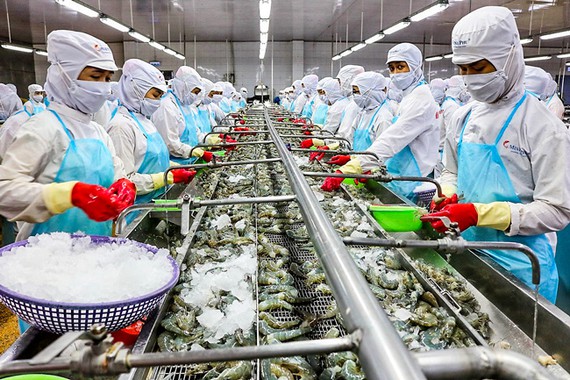Businesses in Vietnam unaffected by India situation
Businesses in Vietnam unaffected by India situation
Export and import businesses in Vietnam are seeing the effect of the new Covid-19 variant outbreak in India on all their activities. Although most businesses are monitoring the situation very closely, it seems there has not been much of an impact on activities within Vietnam, as a result of this virulent outbreak in India.
Illustrative photo.
|
Low India market share
According to the General Department of Customs, Vietnam-India bilateral trade grew positively in the first three months of 2021, reaching USD 3.3 bn, up by 34.1% over the same period last year. In this, exports reached USD 1.71 bn, up 22.2%, and imports reached USD 1.58 bn, up 50% over the same period in 2020. Some industries with strong export turnover, such as tea, increased by 693.8%; coal increased by 256.5%; plastic materials increased by 195%; iron and steel increased by 186%; and handicrafts such as bamboo, rattan and carpets increased by 103.5%.
With such strong growth, it is being questioned whether these industries were much affected in April by the sudden outbreak of the new variant of the Covid-19 in India. Speaking with Saigon Investment, Mr. Hoang Vinh Long, Deputy Secretary-General of the Vietnam Tea Association, said that although tea export turnover for the Indian market increased sharply in recent years, so far India is still not a big market for the tea industry in Vietnam, because India itself is a major source for tea production in the world. Besides, the month of April is often considered dormant in the tea industry because of slack tea production during this month, so the impact on Vietnamese enterprises will not be much.
However, in recent years, the textile and garment industries of Vietnam and India have strongly been promoting trade. In particular, when the pandemic broke out in China, the search for alternative material sources in markets like India was strengthened. According to assessment by Mr. Pham Xuan Hong, Chairman of the Ho Chi Minh City Textile and Garment Association, the pandemic in India has not had much effect on Vietnamese textile enterprises. Currently, Vietnam buys Indian materials and accessories, but these are in very modest amounts. Similarly, other exports to India are also very small, although businesses are continuing to monitor the current situation in India very closely.
At the India-Vietnam Investment Forum held at the end of January, Mr. Pham Sanh Chau, Vietnam's Ambassador to India, said that in recent years, the two-way trade turnover between Vietnam and India has been growing impressively. However, currently, the turnover is about USD 12 bn, so the opportunity to exploit this 1.4 billion peoples market for Vietnamese enterprises is quite huge and attractive.
However, although businesses are not affected much, before the complicated progress of the pandemic in India from mid-April, the Vietnam Trade Office in India had recommended to Vietnamese businesses to regularly contact their Indian partners to update developments and inform of local government blockade measures. Accordingly, it is necessary to discuss with partners to renegotiate the terms of their contracts, conditions of delivery, payment, and discuss occurrence of any unforeseen circumstances. For new orders, to apply safe and beneficial payment terms for businesses, deferred payment methods must not be used.
Export opportunities
Up until now, India has always been a competitor of Vietnam in many export products such as seafoods, textiles, footwear, and tea, to the US or to Europe. When the pandemic spread in India, it already had advantages over some export industries of Vietnam, such as the seafood industry. According to the latest analysis of the Vietnam Association of Seafood Exporters and Producers (Vasep), the current development of Vietnam seafood exports to some countries and regions will have advantages, in which imports into the US will be a bright spot for the seafood industry.
In particular, Vietnamese shrimp will have more opportunities in the US when India, the largest supplier in this market, will face production difficulties due to the Covid-19 pandemic. Experts in the Indian shrimp industry have also determined that this year will be really difficult due to lack of reefer containers, with the cost of transporting goods to increase three times due to rising fuel prices, increased packaging costs, labor costs, removal of export incentives by the government, and the Indian rupee falling against the US dollar.
According to analysis by Vasep, India's present situation which has got out of control, can lead to supply and price disruption, when farmers rush to harvest shrimp early, and factories fail to process in time amid a nationwide lockdown. In addition, Indian shrimp is under attack by the US shrimp industry, in a move to pressure the US government to tax 2% on Indian warm water shrimp, and at the same time bring up allegations of forced labor and the use of banned antibiotics by the Indian shrimp industry. So 2021 can be seen as a dark year for the Indian shrimp industry. Mr. Ho Quoc Luc, Chairman of the Board of Directors of Sao Ta Food Joint Stock Company, emphasized that it is necessary to clarify that at present, Vietnamese enterprises mostly do not import raw shrimp from India because they cannot trace the origin.
Businesses in Vietnam hope that India will soon overcome the current drastic pandemic phase, which will eventually help businesses of both the countries to promote more trade, because India is still a potential market with a very large population. In the first quarter alone, the Vietnam Trade Office in India has implemented about ten direct and online trade promotion programs for many commodities in many states in India. If there is no impact of the pandemic, it is expected that by this May, the Trade Office will coordinate with the Ministry of Industry and Trade to promote agriculture, processed food, as well as the export of dragon fruit from Binh Thuan province.
























